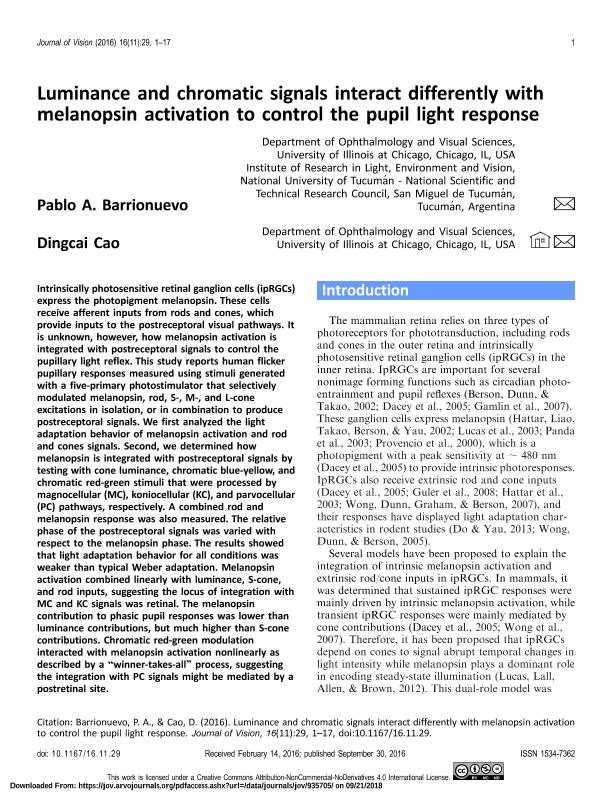Mostrar el registro sencillo del ítem
dc.contributor.author
Barrionuevo, Pablo Alejandro

dc.contributor.author
Cao, Dingcai
dc.date.available
2018-10-01T19:14:40Z
dc.date.issued
2016-08
dc.identifier.citation
Barrionuevo, Pablo Alejandro; Cao, Dingcai; Luminance and chromatic signals interact differently with melanopsin activation to control the pupil light response; Association for Research in Vision and Ophthalmology; Journal of Vision; 16; 11; 8-2016; 1-17
dc.identifier.issn
1534-7362
dc.identifier.uri
http://hdl.handle.net/11336/61419
dc.description.abstract
Intrinsically photosensitive retinal ganglion cells (ipRGCs) express the photopigment melanopsin. These cells receive afferent inputs from rods and cones, which provide inputs to the postreceptoral visual pathways. It is unknown, however, how melanopsin activation is integrated with postreceptoral signals to control the pupillary light reflex. This study reports human flicker pupillary responses measured using stimuli generated with a five-primary photostimulator that selectively modulated melanopsin, rod, S-, M-, and L-cone excitations in isolation, or in combination to produce postreceptoral signals. We first analyzed the light adaptation behavior of melanopsin activation and rod and cones signals. Second, we determined how melanopsin is integrated with postreceptoral signals by testing with cone luminance, chromatic blue-yellow, and chromatic red-green stimuli that were processed by magnocellular (MC), koniocellular (KC), and parvocellular (PC) pathways, respectively. A combined rod and melanopsin response was also measured. The relative phase of the postreceptoral signals was varied with respect to the melanopsin phase. The results showed that light adaptation behavior for all conditions was weaker than typical Weber adaptation. Melanopsin activation combined linearly with luminance, S-cone, and rod inputs, suggesting the locus of integration with MC and KC signals was retinal. The melanopsin contribution to phasic pupil responses was lower than luminance contributions, but much higher than S-cone contributions. Chromatic red-green modulation interacted with melanopsin activation nonlinearly as described by a ''winner-takes-all'' process, suggesting the integration with PC signals might be mediated by a postretinal site.
dc.format
application/pdf
dc.language.iso
eng
dc.publisher
Association for Research in Vision and Ophthalmology

dc.rights
info:eu-repo/semantics/openAccess
dc.rights.uri
https://creativecommons.org/licenses/by-nc-sa/2.5/ar/
dc.subject
Melanopsin
dc.subject
Postreceptoral Pathways
dc.subject
Pupils
dc.subject.classification
Inmunología

dc.subject.classification
Medicina Básica

dc.subject.classification
CIENCIAS MÉDICAS Y DE LA SALUD

dc.title
Luminance and chromatic signals interact differently with melanopsin activation to control the pupil light response
dc.type
info:eu-repo/semantics/article
dc.type
info:ar-repo/semantics/artículo
dc.type
info:eu-repo/semantics/publishedVersion
dc.date.updated
2018-09-18T16:30:25Z
dc.journal.volume
16
dc.journal.number
11
dc.journal.pagination
1-17
dc.journal.pais
Estados Unidos

dc.journal.ciudad
Rockville
dc.description.fil
Fil: Barrionuevo, Pablo Alejandro. Consejo Nacional de Investigaciones Científicas y Técnicas. Centro Científico Tecnológico Conicet - Tucumán. Instituto de Investigación en Luz, Ambiente y Visión. Universidad Nacional de Tucumán. Facultad de Ciencias Exactas y Tecnología. Instituto de Investigación en Luz, Ambiente y Visión; Argentina
dc.description.fil
Fil: Cao, Dingcai. University Of Illinois At Chicago; Estados Unidos
dc.journal.title
Journal of Vision

dc.relation.alternativeid
info:eu-repo/semantics/altIdentifier/url/https://jov.arvojournals.org/article.aspx?articleid=2565122
dc.relation.alternativeid
info:eu-repo/semantics/altIdentifier/doi/http://dx.doi.org/10.1167/16.11.29
Archivos asociados
